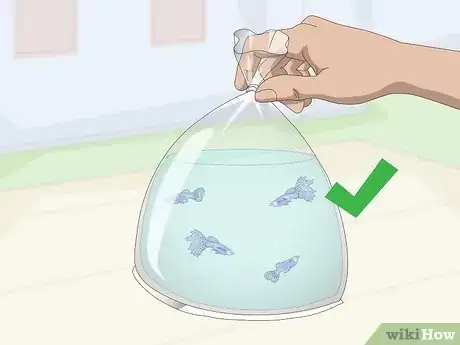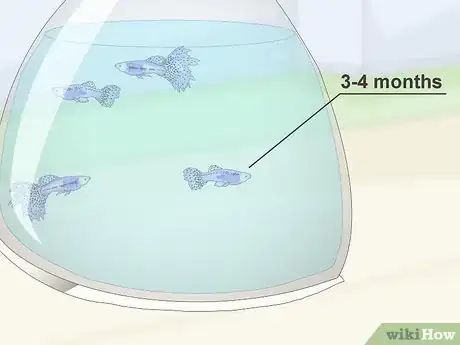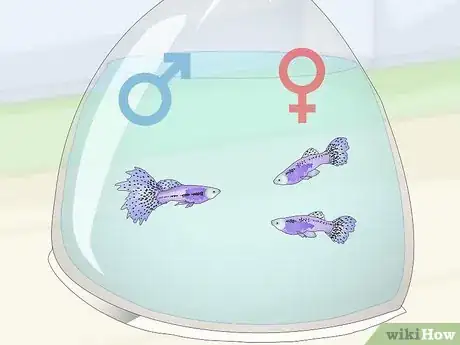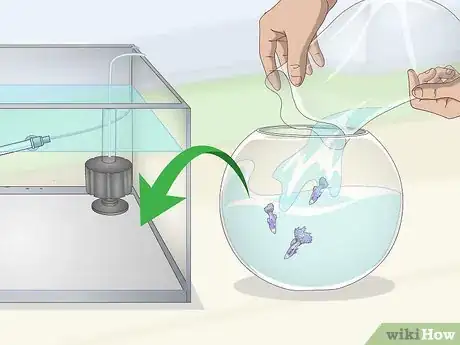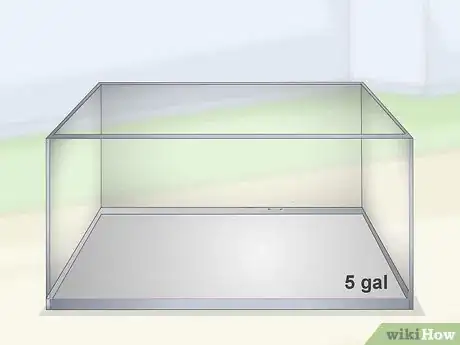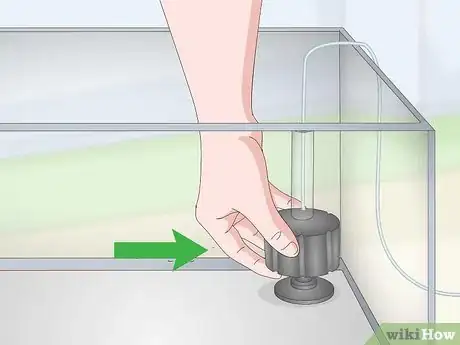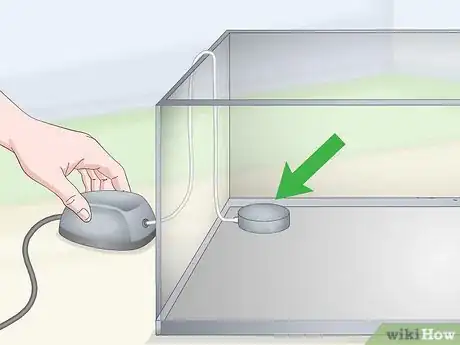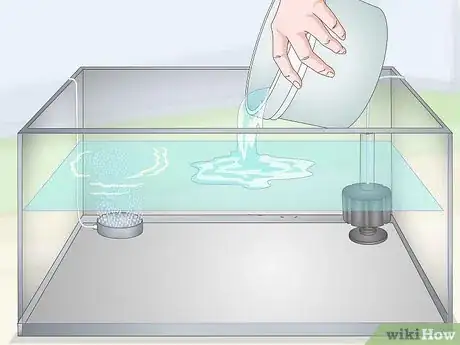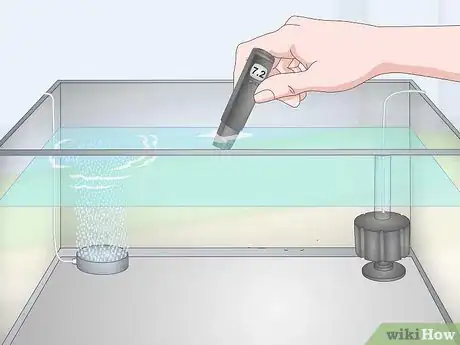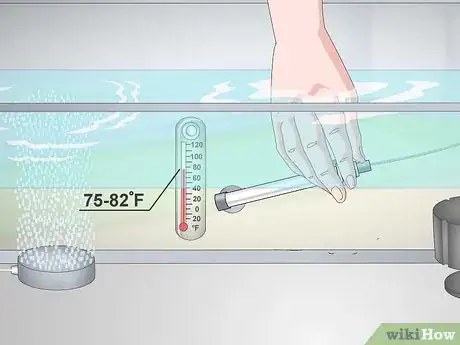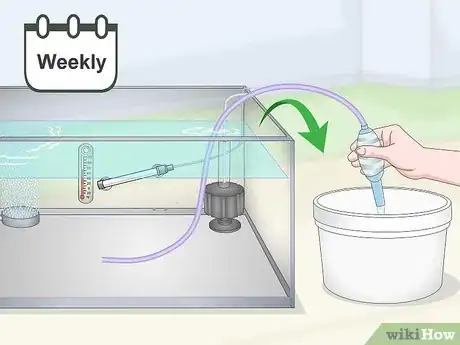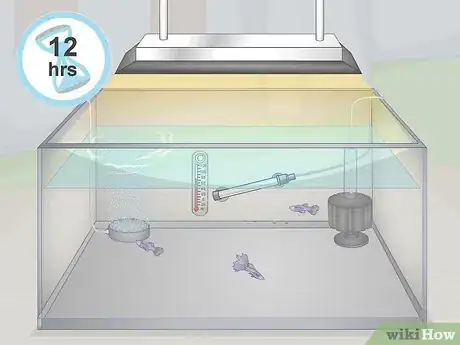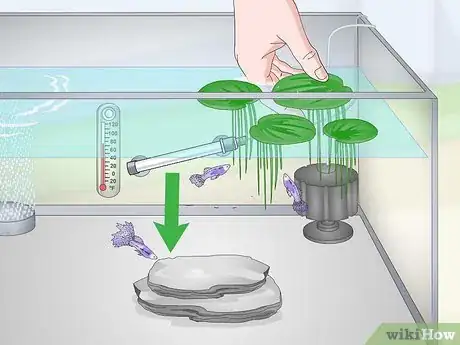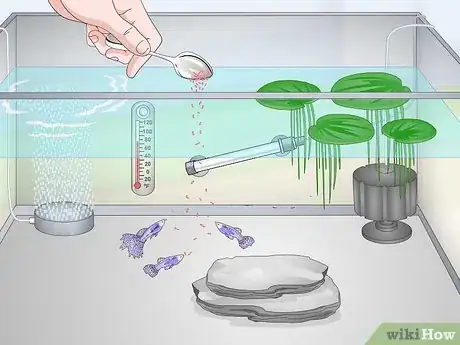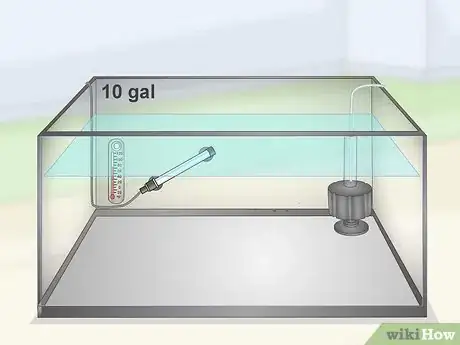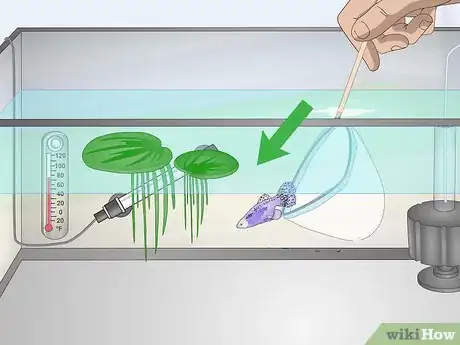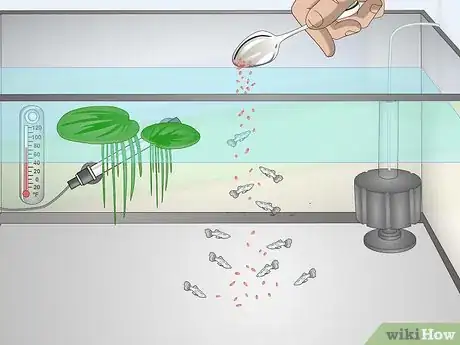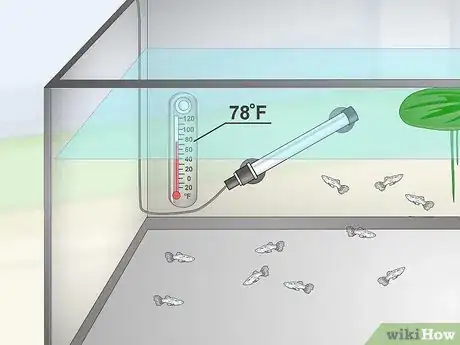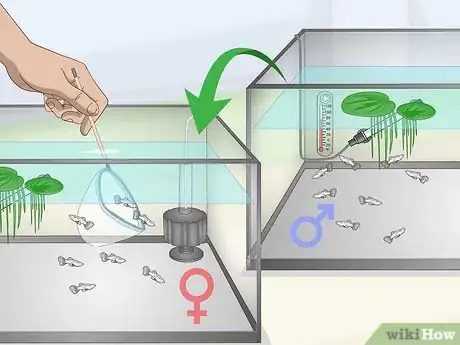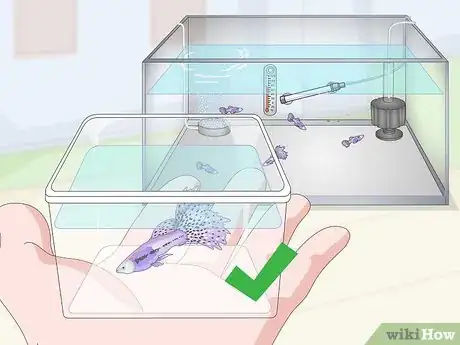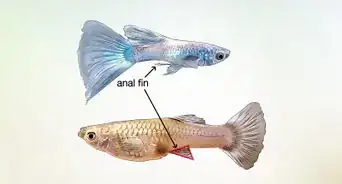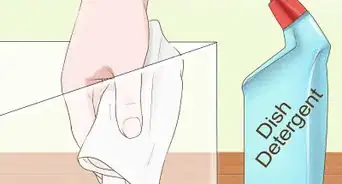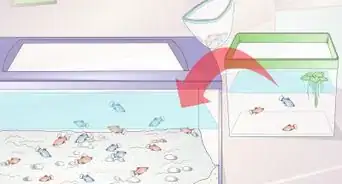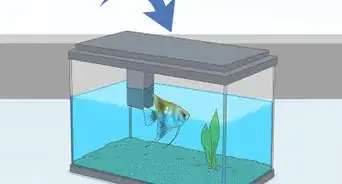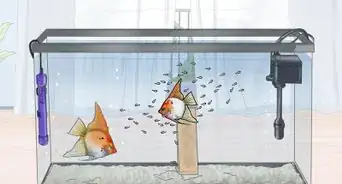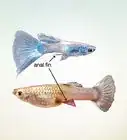This article was co-authored by Marshall Stephens and by wikiHow staff writer, Megaera Lorenz, PhD. Marshall Stephens is an Aquarium Expert at Private Oceans Aquariums in West Palm Beach, Florida. Marshall has over 20 years of experience in the aquarium industry and focuses on captive-bred animals. They specialize in tropical and marine aquariums and are a contributor to the Loggerhead Marine life center in Jupiter Florida.
There are 7 references cited in this article, which can be found at the bottom of the page.
wikiHow marks an article as reader-approved once it receives enough positive feedback. In this case, several readers have written to tell us that this article was helpful to them, earning it our reader-approved status.
This article has been viewed 77,415 times.
Fancy guppies come in a dazzling array of colors and patterns. Like all guppies, they are also relatively easy to care for and breed. If you’re interested in breeding fancy guppies, start by buying some breeding stock in the strain you like best. Set up tanks for your breeding groups and their offspring. As the baby fish grow, provide proper care and food to help them reach their full potential. If you’re a serious show breeder, you’ll also need to cull any fry that don’t fit the standards of your strain.
Steps
Selecting a Breeding Group
-
1Buy fish of a single strain if you want to breed guppies for show. Get familiar with the different strains of fancy guppies available and decide which strain appeals most to you. If you’re new to the world of fish breeding, start with a few individuals of a single strain—otherwise, you may soon find yourself overwhelmed with more guppies than you can handle.[1]
- Fancy guppies exhibit a wide variety of colors, patterns, and tail shapes. Look for a strain that has all the features you like the most (e.g., a bi-color body with a lyre-shaped tail).
-
2Get fish that are 3 to 4 months old and healthy. Younger fish will have an easier time acclimating to a new environment than older fish. Additionally, guppies that are between 3 and 7 months old are at their peak breeding age.[2]
- Don’t select fish that show signs of illness such as white spots on their skin, ragged fins, or swollen bodies with raised scales.[3]
Advertisement -
3Keep your breeding stock in pairs (1 male, 1 female) or trios (1 male, 2 females). Keeping your guppies in small groups makes it easier to keep track of your breeding lines. While you can keep your guppies in male and female pairs if you wish, having a breeding trio allows you to establish 2 separate lines that you can eventually interbreed.[4]
- Maintaining separate breeding lines creates greater genetic diversity, which can reduce the risk of problems resulting from inbreeding.
- If you want to keep several breeding pairs or trios, put each group in its own tank. Otherwise, it will be too difficult to keep track of which offspring come from which parents.
-
4Help your new fish gradually transition into their breeding tank. When you first bring home your new breeding group, place the guppies in a small fishbowl in the same water in which you transported them. Every 15-30 minutes, add a small amount of water from the permanent breeding tank. Once the bowl is ¾ full, replace ½ of the water with water from the breeding tank. Repeat this process 2 or 3 times over the course of an hour, then release the fish into their new home.[5]
- If your guppies act skittish or spend a lot of time hiding when you first put them in the new tank, hold off on feeding them for the first 24-48 hours. Stressed or frightened fish are less likely to eat, and letting food build up in the tank will pollute the water.
- Don’t just dump your new guppies directly into the tank. A sudden change in water conditions can be dangerous or fatal to fish.
Housing and Feeding Your Adult Guppies
-
1Set up a small tank (about 5 gallons (19 L)) for your breeding group. Breeding pairs or trios don’t need a lot of space. Keep the guppies you wish to breed in a tank that’s between 2 gallons (7.6 L) and 5 gallons (19 L) in volume.[6]
- You can keep your breeding groups in larger tanks if you wish, but successfully breeding guppies for show requires that you keep at least 8 to 10 tanks per strain. Using smaller tanks will help you make the most of your space.
-
2Provide box or sponge filters. Your guppy tanks will need filters to keep the water clean and healthy. Box and sponge filters are great options because they are effective, inexpensive, and easy to maintain. Ask an experienced breeder or check with a fish specialist at your local pet store to determine the best option for your tanks.[7]
- While box filters are better at filtering out chemicals and debris, sponge filters have many advantages in a breeding tank. They are easy to clean, good for growing populations of beneficial bacteria, and safer for tiny fish fry than other types of filters.
-
3Place an air pump in each tank. Good air flow will make it easier for your guppies to get oxygen from the water, and the movement provided by a strong air pump can also help your guppies develop stronger muscles.[8] Choose an air pump that is designed to work with the size of tank you are using. You can also use PVC piping to hook a single pump up to several tanks.[9]
- Most box and sponge filters have built-in air pumps, so you may not need additional aeration beyond that provided by your filter.
-
4Fill the tanks with clean, dechlorinated water. If your tap water contains chlorine, you will need to dechlorinate the water before you add it to your tanks. You can do this simply by allowing the water to aerate for 24 hours before using it. You can filter out other chemical contaminants, such as ammonia, by using a filter filled with a purifying medium such as Ammo-Chips.[10]
- Your local pet store may sell special filters or water conditioners designed to create ideal water conditions for your guppies.
-
5Maintain your water at a pH of around 7.2. Guppies do best in water with a slightly alkaline pH of around 7.2, although they can thrive in a pH as low as 6.5.Test the pH of the water in your tanks twice a week to make sure it is within healthy parameters and not changing drastically between tests.[11]
- You can buy pH test kits for your aquarium at most pet stores.
- If you have to adjust the pH of the tank, do so gradually. Making sudden changes to the pH can stress or kill your guppies.[12]
-
6Keep the water temperature between 75–82 °F (24–28 °C). Guppies need relatively warm water in order to successfully breed and grow. Place aquarium thermometers in each tank so that you can carefully monitor water temperatures and keep them within an optimal range.[13]
- If you are maintaining a large number of tanks, you may find it practical to heat the entire room in which you keep the tanks rather than having separate heaters for each tank.
-
7Change the water once a week. Use a siphon to remove about 25% of the water each week. Replace the missing water with clean, dechlorinated water.[14]
-
8Have a light on above the tank for 12 hours a day. Set up a light on a timer above each tank. Guppies need a regular light-dark cycle in order to maintain their natural biological rhythms. Set the timer to keep the light on for 12 hours during the day, and off for 12 hours overnight.[17]
- The lights don’t need to be strong—a 30-40 watt fluorescent bulb over each tank will work well.
- If you have lots of tanks, you can simply light the ceiling above the tanks with several 4 feet (1.2 m) fluorescent bulbs instead of installing a light in the lid of each tank.[18]
- Set the timer so the lights go on 1 hour before the first feeding of the day and go off 1 hour after the last feeding.[19]
-
9Add rocks and floating plants to provide hiding places. Adult guppies like having small, dark spaces to hide out when they are feeling frightened or stressed out. If you wish, you can offer shelter by adding a few rocks with holes in them to your tanks. Floating plants are also helpful for providing hiding places for tiny hatchlings, which are vulnerable to being eaten by older fish.[20]
- There’s no need to add gravel or any other substrate to a breeding or growing tank. In fact, leaving the bottom of the tank bare will make it easier to clean and maintain.
-
10Feed your guppies a variety of animal and plant foods. Guppies are omnivores, and they need a varied and well-balanced diet in order to stay healthy. Offer your guppies a range of foods including baby brine shrimp, spinach, algae, micro worms, and various dry fish foods.[21]
- Guppies do best with several small feedings throughout the day, especially in their first 3 months. Depending on how much they are willing to eat, you may be able to feed your guppies up to 6 to 8 times per day.
- Take care not to overfeed your guppies. Remove any food that is uneaten after about 5 minutes.[22]
- You can also keep a few small Corydoras catfish in the tank to clean up any uneaten food.[23]
Caring for Hatchlings
-
1Get large tanks (at least 10 gallons (38 L)) for the offspring. Guppies tend to produce large quantities of babies (around 30 to 50) in a single drop. You’ll need to move the new hatchlings to a larger environment so that they have room to spread out and grow. 10–20 gallons (38–76 L) tanks are a good choice for groups of new and growing fry.[24]
- Some breeders put juveniles in 10 gallons (38 L) tanks and then transfer their mature show guppies into larger tanks.
- You may also wish to maintain a larger tank for any fish you’d like to cull from the show or breeding groups.[25]
- You will need separate growing tanks for each strain you keep as well as for each family line within a single strain.
-
2Place the pregnant female in a separate tank from the breeding group. As soon as you notice that one of the females in your breeding group is pregnant, remove her from the breeding tank and place her in one of your larger tanks for raising fry. Keep her in the new tank until the babies are born, then put her back in the breeding tank.[26]
- Female guppies give birth to live young rather than laying eggs.
- Baby guppies are self-sufficient and don’t need their parents to help them survive. In fact, keeping the fry in the same tank as an adult puts them at risk of being cannibalized.
- You can put spawning grass or floating plants in the tank with the pregnant female to offer the hatchlings a place to hide until you’ve had a chance to remove the mother.
-
3Feed the baby guppies newly hatched brine shrimp. Newborn brine shrimp are the best source of nutrients for baby guppies. Feed your fry 2 or more small meals of brine shrimp every day.[27] After the first 2 days, you can add some very finely-ground flake food to their diet.[28]
- Once the babies are past the age of 6 weeks, you can begin to offer them a more varied adult diet.
-
4Keep the water around 78 °F (26 °C). Guppy fry do best in slightly warmer water than adults. For the first 4 months of their lives, maintain their tanks at around 78 °F (26 °C). From 4-8 months, you can reduce the temperature by a couple degrees to about 76 °F (24 °C), and then 74 °F (23 °C) as they enter adulthood.[29]
-
5Separate the males from the females at 3 to 6 weeks of age. Separating the male and female guppies will give the growing fry more space and prevent unwanted breeding as they mature. To recognize the females, look for a small, dark spot at the base of the belly, just behind the anal fin. This is called the gravid spot.[31]
- Place the males and females in separate growing tanks. A tank that is 10–20 gallons (38–76 L) should work well for this purpose.
- Limit the number of young in a tank to 1 fish per 1 gallon (3.8 L).
-
6Select the fish you want to keep for breeding or show. Since guppies produce so many young, you will need to cull each group of offspring and select the best fish to continue your breeding lines. Cull any fish that are sickly, deformed, or do not meet the standards of the strain you are breeding.[32]
- There are a variety of ways to handle culling. If you wish, you can sell or trade your culled fish at a local pet store, or keep them in their own tank as non-breeding pets.[33]
- Some breeders keep or give away deformed guppy fry for use as feeder fish (e.g., to feed carnivorous fish or reptiles).[34]
Community Q&A
Did you know you can get answers researched by wikiHow Staff?
Unlock staff-researched answers by supporting wikiHow
-
QuestionHow much brine shrimp eggs do you feed to the guppies?
 wikiHow Staff EditorThis answer was written by one of our trained team of researchers who validated it for accuracy and comprehensiveness.
wikiHow Staff EditorThis answer was written by one of our trained team of researchers who validated it for accuracy and comprehensiveness.
Staff Answer wikiHow Staff EditorStaff Answer
wikiHow Staff EditorStaff Answer -
QuestionWhen I set up my tank I put the water in a bucket and put the "good bacteria grower" in. After a day I dumped it in my tank. Will that ruin the job it's supposed to do? I was afraid so I put in more.
 wikiHow Staff EditorThis answer was written by one of our trained team of researchers who validated it for accuracy and comprehensiveness.
wikiHow Staff EditorThis answer was written by one of our trained team of researchers who validated it for accuracy and comprehensiveness.
Staff Answer wikiHow Staff EditorStaff AnswerDifferent bacterial supplements may work in different ways, so consult the directions on the packaging to find out the best way to incorporate the supplement into your tank. Many aquarium enthusiasts recommend skipping bacterial supplements and cycling your tank naturally by adding some hardy fish (such as danios or minnows) or letting the tank run for a few days with a tiny amount of flake food in the water.
wikiHow Staff EditorStaff AnswerDifferent bacterial supplements may work in different ways, so consult the directions on the packaging to find out the best way to incorporate the supplement into your tank. Many aquarium enthusiasts recommend skipping bacterial supplements and cycling your tank naturally by adding some hardy fish (such as danios or minnows) or letting the tank run for a few days with a tiny amount of flake food in the water. -
QuestionWhere can I sell guppies?
 Community AnswerYou can sell guppies to your local pet store, who will then of course sell them for a higher price to other people. You can also sell to friends and acquaintances who are interested.
Community AnswerYou can sell guppies to your local pet store, who will then of course sell them for a higher price to other people. You can also sell to friends and acquaintances who are interested.
Things You’ll Need
- A breeding pair or trio of fancy guppies
- A breeding tank (at least 2–5 gallons (7.6–18.9 L))
- Several growing tanks (8-10 per strain), at least 10–20 gallons (38–76 L)
- Box or sponge filters
- Air pumps
- Rocks with hiding holes for guppies
- Floating plants
- Spawning grass
- Tank heaters and thermometers
- 30-40 watt fluorescent tank lights with timers
- Baby brine shrimp for your hatchlings
- A variety of fish foods for adult guppies, including brine shrimp, micro worms, spinach, algae, and flake foods
References
- ↑ https://www.ifga.org/basicbreeding
- ↑ https://www.ifga.org/basicbreeding
- ↑ http://guppyaquarium.com/guppy-diseases-and-treatment/
- ↑ https://www.ifga.org/basicbreeding
- ↑ https://www.ifga.org/basicbreeding
- ↑ https://www.ifga.org/basiccare
- ↑ https://www.ifga.org/basiccare
- ↑ https://www.practicalfishkeeping.co.uk/features/articles/how-to-breed-perfect-guppies
- ↑ https://www.ifga.org/basiccare
- ↑ https://www.ifga.org/basiccare
- ↑ https://www.practicalfishkeeping.co.uk/features/articles/how-to-breed-perfect-guppies
- ↑ https://www.ifga.org/basiccare
- ↑ https://www.ifga.org/basiccare
- ↑ https://www.practicalfishkeeping.co.uk/features/articles/how-to-breed-perfect-guppies
- ↑ https://www.ifga.org/basiccare
- ↑ https://www.guppychicago.org/articles/getting-started-guppy-tips/
- ↑ https://www.practicalfishkeeping.co.uk/features/articles/how-to-breed-perfect-guppies
- ↑ https://www.ifga.org/basiccare
- ↑ https://www.ifga.org/basiccare
- ↑ http://www.tfhmagazine.com/details/articles/back-to-the-basics-breeding-guppies.htm
- ↑ https://www.ifga.org/basiccare
- ↑ http://www.tfhmagazine.com/details/articles/back-to-the-basics-breeding-guppies.htm
- ↑ http://www.tfhmagazine.com/details/articles/back-to-the-basics-breeding-guppies.htm
- ↑ https://www.ifga.org/basiccare
- ↑ https://www.guppychicago.org/articles/taking-young-record-keeping-culling-by-tom-allen/
- ↑ https://www.ifga.org/basicbreeding
- ↑ http://www.tfhmagazine.com/details/articles/back-to-the-basics-breeding-guppies.htm
- ↑ https://www.ifga.org/basiccare
- ↑ https://www.practicalfishkeeping.co.uk/features/articles/how-to-breed-perfect-guppies
- ↑ http://www.tfhmagazine.com/details/articles/back-to-the-basics-breeding-guppies.htm
- ↑ https://www.ifga.org/basicbreeding
- ↑ https://www.ifga.org/basicbreeding
- ↑ https://www.guppychicago.org/articles/taking-young-record-keeping-culling-by-tom-allen/
- ↑ https://www.guppychicago.org/articles/taking-young-record-keeping-culling-by-tom-allen/
- ↑ https://www.ifga.org/basicbreeding
About This Article
If you want to keep and breed fancy guppies, keep your breeding pair or trio in a tank that holds about 2-5 gallons of water. Place a box or sponge filter and an air pump in the tank, and maintain the water pH at around 7.2. Once a week, remove about 25% of the water in the tank and replace it with clean, dechlorinated water. To encourage the guppies to breed, place a light above the tank, and set a timer to keep the lights on for 12 hours during the day and off for 12 hours at night. For tips on caring for guppy hatchlings, keep reading!
